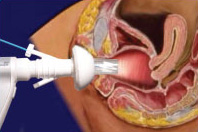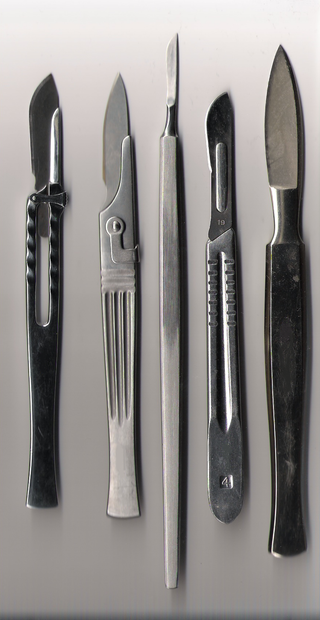Related Research Articles

Ultrasound is sound with frequencies greater than 20 kilohertz. This frequency is the approximate upper audible limit of human hearing in healthy young adults. The physical principles of acoustic waves apply to any frequency range, including ultrasound. Ultrasonic devices operate with frequencies from 20 kHz up to several gigahertz.
Obstetrics and gynaecology is the medical specialty that encompasses the two subspecialties of obstetrics and gynaecology. The specialization is an important part of care for women's health.

Gynaecology or gynecology is the area of medicine that involves the treatment of women's diseases, especially those of the reproductive organs. It is often paired with the field of obstetrics, forming the combined area of obstetrics and gynaecology (OB-GYN).

Medical ultrasound includes diagnostic techniques using ultrasound, as well as therapeutic applications of ultrasound. In diagnosis, it is used to create an image of internal body structures such as tendons, muscles, joints, blood vessels, and internal organs, to measure some characteristics or to generate an informative audible sound. The usage of ultrasound to produce visual images for medicine is called medical ultrasonography or simply sonography, or echography. The practice of examining pregnant women using ultrasound is called obstetric ultrasonography, and was an early development of clinical ultrasonography. The machine used is called an ultrasound machine, a sonograph or an echograph. The visual image formed using this technique is called an ultrasonogram, a sonogram or an echogram.

Echocardiography, also known as cardiac ultrasound, is the use of ultrasound to examine the heart. It is a type of medical imaging, using standard ultrasound or Doppler ultrasound. The visual image formed using this technique is called an echocardiogram, a cardiac echo, or simply an echo.

Obstetric ultrasonography, or prenatal ultrasound, is the use of medical ultrasonography in pregnancy, in which sound waves are used to create real-time visual images of the developing embryo or fetus in the uterus (womb). The procedure is a standard part of prenatal care in many countries, as it can provide a variety of information about the health of the mother, the timing and progress of the pregnancy, and the health and development of the embryo or fetus.

Erotic electrostimulation is a sexual practice involving the application of electrical stimulation to the nerves of the body, with particular emphasis on the genitals, using a power source for purposes of sexual stimulation. Electrostimulation has been associated with BDSM activities, and erotic electrostimulation is an evolution of that practice.

Fatty liver disease (FLD), also known as hepatic steatosis and steatotic liver disease (SLD), is a condition where excess fat builds up in the liver. Often there are no or few symptoms. Occasionally there may be tiredness or pain in the upper right side of the abdomen. Complications may include cirrhosis, liver cancer, and esophageal varices.

A surgical instrument is a medical device for performing specific actions or carrying out desired effects during a surgery or operation, such as modifying biological tissue, or to provide access for viewing it. Over time, many different kinds of surgical instruments and tools have been invented. Some surgical instruments are designed for general use in all sorts of surgeries, while others are designed for only certain specialties or specific procedures.
An oxygen concentrator is a device that concentrates the oxygen from a gas supply by selectively removing nitrogen to supply an oxygen-enriched product gas stream. They are used industrially, to provide supplemental oxygen at high altitudes, and as medical devices for oxygen therapy.

Transcranial Doppler (TCD) and transcranial color Doppler (TCCD) are types of Doppler ultrasonography that measure the velocity of blood flow through the brain's blood vessels by measuring the echoes of ultrasound waves moving transcranially. These modes of medical imaging conduct a spectral analysis of the acoustic signals they receive and can therefore be classified as methods of active acoustocerebrography. They are used as tests to help diagnose emboli, stenosis, vasospasm from a subarachnoid hemorrhage, and other problems. These relatively quick and inexpensive tests are growing in popularity. The tests are effective for detecting sickle cell disease, ischemic cerebrovascular disease, subarachnoid hemorrhage, arteriovenous malformations, and cerebral circulatory arrest. The tests are possibly useful for perioperative monitoring and meningeal infection. The equipment used for these tests is becoming increasingly portable, making it possible for a clinician to travel to a hospital, to a doctor's office, or to a nursing home for both inpatient and outpatient studies. The tests are often used in conjunction with other tests such as MRI, MRA, carotid duplex ultrasound and CT scans. The tests are also used for research in cognitive neuroscience.

Ultrasonic transducers and ultrasonic sensors are devices that generate or sense ultrasound energy. They can be divided into three broad categories: transmitters, receivers and transceivers. Transmitters convert electrical signals into ultrasound, receivers convert ultrasound into electrical signals, and transceivers can both transmit and receive ultrasound.
Emergency ultrasound employing point-of-care ultrasound (POCUS) is the application of ultrasound at the point of care to make immediate patient-care decisions. It is performed by the health care professional caring for the injured or ill persons. This point-of-care use of ultrasound is often to evaluate an emergency medical condition, in settings such as an emergency department, critical care unit, ambulance, or combat zone.

An electric battery is a source of electric power consisting of one or more electrochemical cells with external connections for powering electrical devices. When a battery is supplying power, its positive terminal is the cathode and its negative terminal is the anode. The terminal marked negative is the source of electrons that will flow through an external electric circuit to the positive terminal. When a battery is connected to an external electric load, a redox reaction converts high-energy reactants to lower-energy products, and the free-energy difference is delivered to the external circuit as electrical energy. Historically the term "battery" specifically referred to a device composed of multiple cells; however, the usage has evolved to include devices composed of a single cell.
Prehospital ultrasound is the specialized application of ultrasound by paramedics, to guide immediate care and treatment procedures. Like conventional ultrasound, it is a device that produces cyclic sound pressure to penetrate a medium (flesh) and reveal details about the inner structure of the medium.

A medical tricorder is a handheld portable scanning device to be used by consumers to self-diagnose medical conditions within seconds and take basic vital measurements. While the device is not yet on the mass market, there are numerous reports of other scientists and inventors also working to create such a device as well as improve it. A common view is that it will be a general-purpose tool similar in functionality to a Swiss Army Knife to take health measurements such as blood pressure and temperature, and blood flow in a noninvasive way. It would diagnose a person's state of health after analyzing the data, either as a standalone device or as a connection to medical databases via an Internet connection.

Doppler ultrasonography is medical ultrasonography that employs the Doppler effect to perform imaging of the movement of tissues and body fluids, and their relative velocity to the probe. By calculating the frequency shift of a particular sample volume, for example, flow in an artery or a jet of blood flow over a heart valve, its speed and direction can be determined and visualized.
Gaumard Scientific is a Miami, Florida-based company that creates simulators for major teaching hospitals and nursing schools, medical military training and emergency medical services. The company traces its history to 1946 and has 300 employees.
An obstetric hospitalist is an obstetrician and gynaecologist physician who is either employed by a hospital or a physician practice and whose duties include providing care for laboring patients and managing obstetric emergencies. Some obstetrics hospitalists also have responsibilities including resident and medical student teaching; providing backup support for family practitioners and nurse midwives, assisting private physicians with surgery, assuming care for ob-gyn patients unassigned to a physician and providing vacation coverage for the private practicing physician.
Terason, a division of Teratech Corporation, is a global medical ultrasound imaging company headquartered in Burlington, Massachusetts, USA. Terason was the first to patent color portable ultrasound and is a market leader in ultrasound-guided venous intervention. Terason produces portable ultrasound products and technologies and has provided ultrasound systems to clinicians, hospitals, outpatient centers, and OEM partners since 2000.
References
- ↑ History of ultrasound in OB/GYN
- ↑ Sonosite company history
- ↑ Case study on Ecton, archived from the original on 2009-02-16, retrieved 2009-05-07
- ↑ Acuson company history
- ↑ Enith Vlooswijk (1 November 2014). "Minivisor (1975 - jaren tachtig)" (in Dutch). de Volkskrant . Retrieved 21 December 2016.
- ↑ "Terason's History". Terason. Retrieved 2022-11-30.
- ↑ Chiang, A.M.; Chang, P.P.; Broadstone, S.R. (October 2000). "PC-based ultrasound imaging system in a probe". 2000 IEEE Ultrasonics Symposium. Proceedings. An International Symposium (Cat. No.00CH37121). Vol. 2. pp. 1255–1260 vol.2. doi:10.1109/ULTSYM.2000.921551. ISBN 0-7803-6365-5. S2CID 6901598.
- ↑ Costantino A, Piagnani A, Caccia R, Sorge A, Maggioni M, Perbellini R, Donato F, D'Ambrosio R, Sed NPO, Valenti L, Prati D, Vecchi M, Lampertico P, Fraquelli M. Reproducibility and accuracy of a pocket-size ultrasound device in assessing liver steatosis. Dig Liver Dis. 2023 Nov 27:S1590-8658(23)01032-0. doi: 10.1016/j.dld.2023.11.014. Epub ahead of print. PMID 38016894.
- ↑ Costantino A, Piagnani A, Nandi N, Sciola V, Maggioni M, Donato F, Vecchi M, Lampertico P, Casazza G, Fraquelli M. Reproducibility and diagnostic accuracy of pocket-sized ultrasound devices in ruling out compensated cirrhosis of mixed etiology. Eur Radiol. 2022 Jul;32(7):4609-4615. doi: 10.1007/s00330-022-08572-2. Epub 2022 Mar 3. PMID 35238968; PMCID: PMC9213370.
- ↑ Nelson BP, Chason K (December 2008). "Use of ultrasound by emergency medical services: a review". International Journal of Emergency Medicine. 1 (4): 253–259. doi:10.1007/s12245-008-0075-6. PMC 2657261 . PMID 19384639.